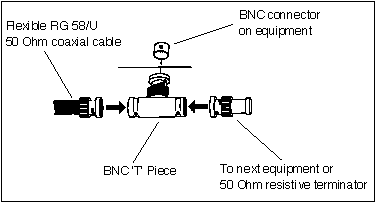
One form of cabling supported by Ethernet is low-cost 50 Ohm coaxial cable, as shown in the figure below. This type of cable is cheap to purchase and is flexible. It is very easy to install. It became known in the communications industry as "Thin Ethernet", so called to differentiate it to "Thick Ethernet", which was specified for early Ethernet LANs. The official name for this cable is 10 Baseband2 (10B2), indicating that it is specified for baseband communications (i.e. not modulated signals) at 10 Mbps over a cable segment and targeting a cable segment length not exceeding 200m (the "2" in "10B2"). The group recognised that RG58 flexible coax had a lower specification than the 10B5 cable, and the low cost BNC connectors introduced more reflection. However, the result was less good than they hoped, and the final actual specification specified an upper limit of 185m.

The connection to a network interface card supporting 10B2 cabling is usually via a BNC connector, as shown in the figure. Sometimes, as in this figure, an AUI port is also provided as an alternative to connect other media (e.g. 10B5, or 10BF). Networks are built by connecting a “T” joiner(1), to the NIC and a length of BNC cable to each side of the joiner (2). This forms a cable segment. A 50 Ohm BNC terminator is added to the last NICs at each of the cable (3).

10B2 cabling is flexible and the network may be constructed in any convenient way by simply connecting all the NICs to the cable segmemt (see below).

Flexibility is not always an asset! There were many stories of users not understanding the bus topology, and unplugging or extending busses to create faults (loops, cable stubs, disconnected lengths of cable). Detecting and resolving faults with 10B2 was never easy, because a could network might work for some users (close-by), but not for others (perhaps who suffered more the effects of cable stubs or where further away).
When this technology was common, some buildings used a special type of connector in place of the more common BNC. This was to try to prevent problems arising when users disconnect or reconnect their equipment. This types of connector is now rare.
A summary of the properties of this type of cabling is given below: